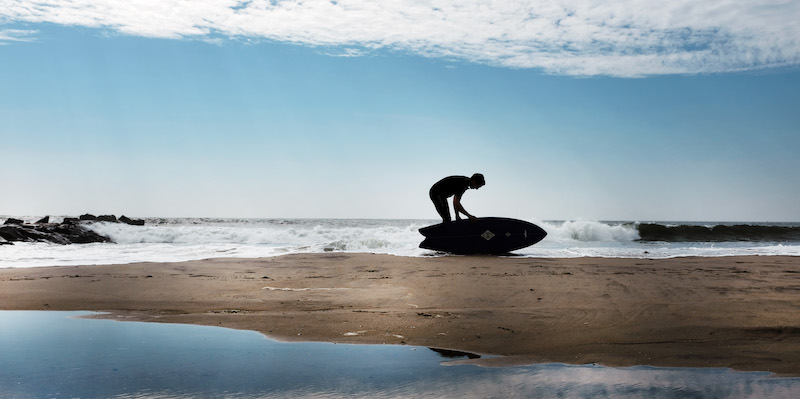British explorer and navigator James Cook was among the first to to describe the practice of surfing, after having observed some Polynesians who got carried away by the waves on rudimentary wooden boards in the Pacific Ocean. Later other sources would have been added from other parts of the world on similar practices, which finally contributed to the birth of the sport we know today and which is practiced by millions of people, more or less able to remain standing on a wave. But learning to balance on the board is of little use if you don’t know the right places to surf. Some are strange, others kept as hidden as possible by enthusiasts, yet many have a trait in common: the risk of depletion of waves due to climate change.
Unlike other areas where the effects of global warming are increasingly clear and evident, in the case of surfing there are still conflicting opinions. On the one hand, the greater frequency and intensity of winds and storms favors the formation of large waves ideals for surfing, but on the other hand the addition of other effects caused by global warming could gradually reduce the amount of suitable places to go out on the sea with a board to face adequate waves.
In general, waves are formed by winds blowing over the oceans and releasing part of their energy into the water. The wave motion can continue for hundreds of kilometers and affect a rather deep column of water. When the waves approach the coast, the bottom becomes shallower, friction increases, the water column decreases and the energy still present causes the wave to ripple and eventually break.
The shape of the seabed greatly influences this process: in principle the steeper it is, and therefore the sudden the reduction of the water column, the more the wave rises as it breaks. A natural element, such as a coral reef, can also make the sudden rise of the wave possible.
The areas where the ideal waves for surfing form and break are defined as “surf break”, which in turn can be of various types. We speak of a “reef break” when the waves break near a coral reef and a “beach break” if it is the conformation of the beach along the coast that favors the breaking of the waves.
Florida, USA (Joe Raedle/Getty Images)
Surf breaks often have their own cyclicity, i.e. they lead to ideal waves for surfing only at certain times, for example when there is high or low tide. And for this reason some research estimates that due to rising seas there could be a profound change in the geography of surfing.
An analysis conduct in 2017 of 105 surf spots in California, for example, he estimated that by the end of the century about a third of those spots will be at risk of disappearing due to sea level rise: Waves will break too close to shore to be ridden, or they just won’t form like they do today.
It is inevitable that as sea levels rise, some surf breaks will change significantly. As we have seen, one of the factors determining wave formation and breaking is the distance between the water surface and the seabed. Waves are expected to become smaller as sea level rises, while other changes will result from the type of surf break.
Those that depend on the high tide today will be places in the future ideals for surfing at low tide, because the sea level will be higher on average in that condition, while the surf breaks that exist today only at low tide will cease to exist (because low tide will still be higher than before due to the ‘rising seas).

Estoril, Portogallo (Jamie McDonald/Getty Images for Laureus)
Changes in sea levels, the greater transport of sediments by rivers swollen by heavier rains than in the past and other factors will also affect the shape of the coasts and seabeds in their vicinity, causing further changes that could make many surf breaks disappear . On the other hand, the phenomenon could lead to the formation of new ideal places for surfing, but there would still be problems linked, for example, to the presence of invasions of algae, in places where the temperature of the sea water will increase the most.
Some of the Pacific surf breaks coincide with areas where sea level rise could have serious effects on coastal populations. Plans to protect them include the construction of concrete barriers and other systems to reduce the risk of flooding, structures that would spell an end to surfing in many of those areas. For some communities, however, surf tourism is the main economic resource, as a result it is difficult to find the right balance between their economic and environmental interests.
Come Report an article on the site Heatmap, dedicated to problems related to climate change, there are associations such as Save the Waves that try to promote more sustainable approaches and compromise solutions. Where possible, the rebuilding of sand dunes along beaches or the introduction of laws to protect surf breaks are considered solutions to mitigate the problem. However, surfing is practiced by a small number of people, as a result many believe that the compromise solutions end up favoring an activity they consider frivolous compared to the protection of their homes.
Save the Waves and other organizations have proposed that the state of California relocate people living in coastal areas at risk. According to some estimates, an important part will still be made inaccessible by the rise in sea level within 2050, therefore activities to incentivize transfers should be launched.
Perhaps the ability of mankind to survive global warming will not depend on the future of surfing, but the story is exemplary to remind us how much climate change puts us in front of difficult choices every day where today’s winners will often be tomorrow’s losers and vice versa .
